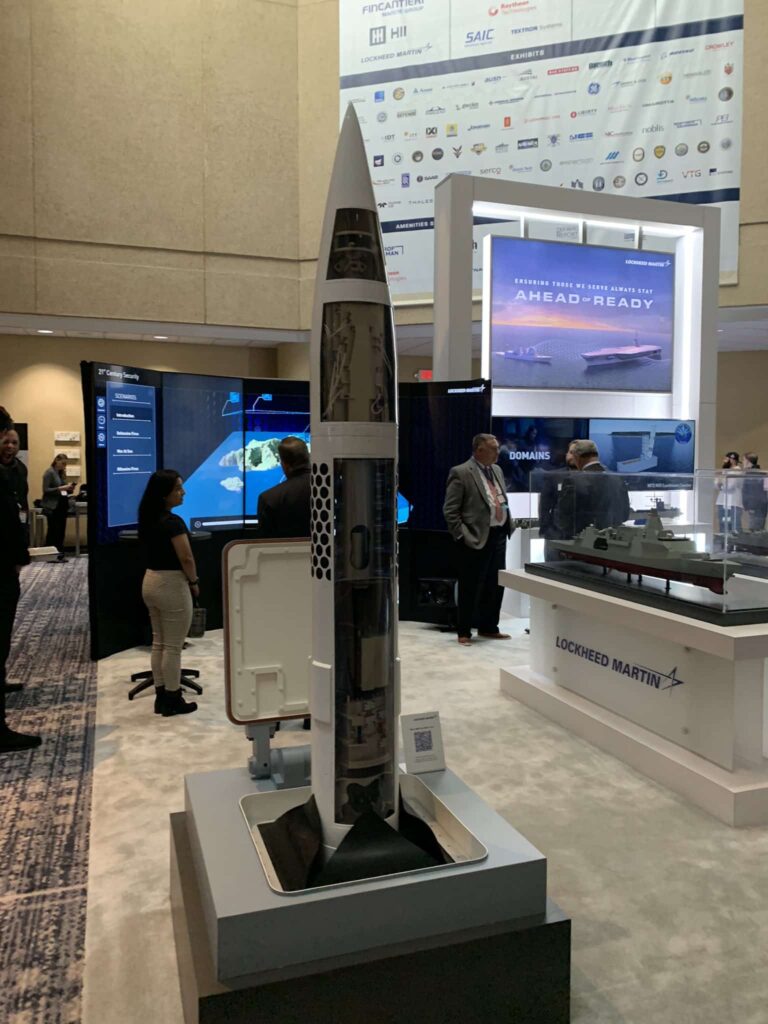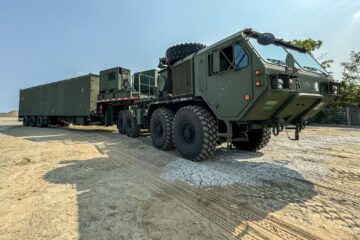Lockheed Martin showcased a Mark 41 Vertical Launch System (VLS) capable Patriot missile for the first time at the Surface Navy Association (SNA) 2023 National Symposium. The display consisted of a single Patriot Advanced Capability-3 Missile Segment Enhancement (PAC-3 MSE) launching from one Mk 41 VLS cell.

Tom Cavanaugh of Lockheed Martin Missiles and Fire Control highlighted efforts to integrate the PAC-3 MSE into the AEGIS Weapons System:
“We’ve conducted some testing and integration work for the government already where we’ve demonstrated the capability at different levels of system integration across the AEGIS Weapon System that will eventually lead to a flight test in the near future on there (referring to the display), but it’s fully integrated with the AEGIS Weapons System.”
Thomas Copeman, VP of Naval Systems, Lockheed Martin Missiles and Fire Control, states in our video interview that Patriot has been integrated with AEGIS in previous efforts with AEGIS Ashore, a land-based version of the AEGIS Weapons System focused on Ballistic Missile Defense (BMD), at the Pacific Missile Range Facility:
Both Lockheed Martin representatives brought up various reasons why Patriot would be a good alternative to the U.S. Navy’s (USN) current Standard Missile series.
Cavanaugh emphasized how PAC-3 MSE’s capabilities, such as its hit-to-kill interceptor, active Ka-band seeker, and altitude control motors, bring a new dimension to USN anti-aircraft warfare.

“So it kind of changes the calculus and how our adversaries effectors are focused on our platforms and how they’ve had you know, they just weapon systems been in the fleet for over 50 years Standard Missile has been out there with them. Or adversaries have designed measures to counter those systems. This changes that calculus using this weapon. So it brings the Navy a great capability.”
Another aspect that Cavanaugh remarked on was PAC-3 MSE’s longstanding, and expanding production line, which in turn can provide the USN with another source for BMD-capable missiles.
“We’re at a 500 missile per year production rate ramped up to 550 by the end of the year by the end of 2023. And then we’re investing in facilitation to increase that production as well.”

PAC-3 MSE could supplement SM series missiles in the critical role of BMD in the fleet. As a comparison, the current SM-6 production is 125 missiles a year with the line planning to produce 200 per year by 2026.
While the length of the Mk 41 VLS needed to support PAC-3 MSE isn’t mentioned, Copeland confirmed the missile doesn’t need “strike length” silos. Lockheed Martin intends to make it capable across all Mk 41 VLS-equipped vessels across the fleet.
The concept of VLS launched Patriot has been around for a while. However, Cavanaugh stated that recent interest from the USN has reinvigorated Lockheed Martin’s development on the Mk 41 VLS-capable Patriot.
“Oh yeah, we’ve looked at this before. There’s more interest from the U.S. Navy. I would say there’s more focus on it now. We’ve progressed significantly last year in our integration efforts and demonstrated that integration to the U.S. government.”
Naval News could not receive comment on exactly why the USN’s interest has increased to the point of the concept making its debut at SNA.
This concept follows Lockheed Martin’s efforts in joining together Army and Navy programs, as previously seen with the successful Long-Range Hypersonic Weapon and Mid-Range Capability.






